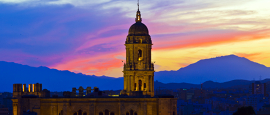Málaga History
Malaga doesn’t try to hide her history: the port, the Roman theatre, the Alcazaba, the art, the unfinished Renaissance cathedral, even the tapas show scars of a bygone era.
The Bastetani were the first to settle in Malaga, but it wasn’t until the Phoenicians established a home here in 770BC that the city was bestowed with its first name - Malaka.
The Roman Republic came to rule the city in 218BC, before merging with the Roman Empire at the end of the first century, when the Roman theatre was built. When the Empire fell, the Byzantine Empire seized upon the city and held onto it until AD624 when they were banished by the Visigoths.
Malaga was one of the many cities invaded and conquered during the Umayyad conquest of Hispania. Soon after, city walls were erected for protection. The Alcazaba fortress was built and the city began to flourish as a port.
The Reconquista reached the city in 1487 and Malaga was under siege for four months until the Catholic Monarchs wrestled the city from Muslim rule.
Earthquakes rocked the city in 1494 and 1680, before some 26,000 residents died in yellow fever epidemics in 1741 and 1800. Industry declined as trade agreements were torn up and a phylloxera outbreak in the late 19th century destroyed vineyard crops.
In 1907, rising water levels along the Rio Guadalmedina tore out a bridge. It crashed into two more bridges downstream, causing flooding which injured 21 locals.
During the Spanish Civil War, the Battle of Malaga in 1937 left 4,000 Republicans dead as Nationalists stormed the city. It wasn’t Malaga’s last tragedy though, as in 1982 a flight heading for New York aborted its take-off, went through the airport fence, crossed the motorway and burst into flames.
Did you know?
• In 1487, the first-ever ambulances (actually bedded wagons) appeared in Malaga to take the wounded away from the front line.
• Pablo Picasso was born here in 1881.
• The Germans’ Bridge was gifted to Malaga by Germany in 1909 to thank residents for assisting a wrecked German frigate in 1900.
Do you have any Feedback about this page?
© 2025 Columbus Travel Media Ltd. All rights reserved. No part of this site may be reproduced without our written permission, click here for information on Columbus Content Solutions.




 You know where
You know where